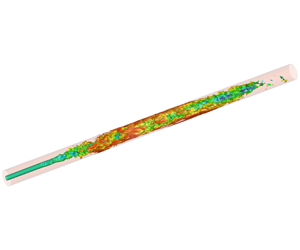Published online by Cambridge University Press: 28 May 2020

We present findings on scalar flashes, turbulent spots and transition statistics in a direct numerical simulation of a 500 radius-long pipe flow with a radial-mode inlet disturbance. Transitional spots are found to contain two different types of eddies. The wall region consists primarily of ‘reverse hairpin vortices’. This unusual structure is related to the high-speed streaks arising from the prescribed inlet perturbation. The core region is populated by the normally observed ‘forward’ hairpin vortices. Number density of the reverse hairpins is quantified indirectly and conservatively by measuring the number density of negative skin-friction patches. During the late stages of transition, second-order statistics such as Reynolds stresses and the rate of dissipation of turbulent kinetic energy exhibit substantial overshoot. This is associated with mid-to-high frequency content in the energy spectra that exceeds the corresponding levels in fully developed turbulence. Flow visualizations reveal bursts of small-scale vortex motions, including the reverse hairpins, that probably account for the enhanced mid-to-high frequency spectral content. A passive scalar is injected at the centreline of the inlet plane, mimicking laboratory injection of dye through a needle, to investigate the mysterious phenomenon of turbulent scalar patches residing in fully developed turbulent pipe flow. At several hundred radii downstream of transition where the velocity field is genuine fully developed turbulence, the scalar patches retain persistent memory of events far upstream. Comparing the present flow with a similar pipe flow disturbed by a significantly different inlet condition suggests that the foregoing observations are insensitive to the form of the disturbances.